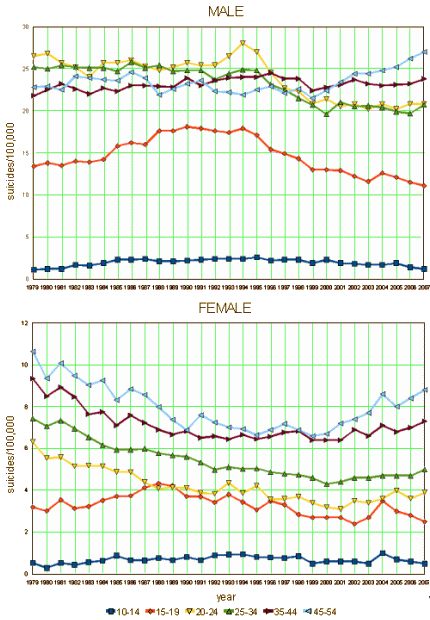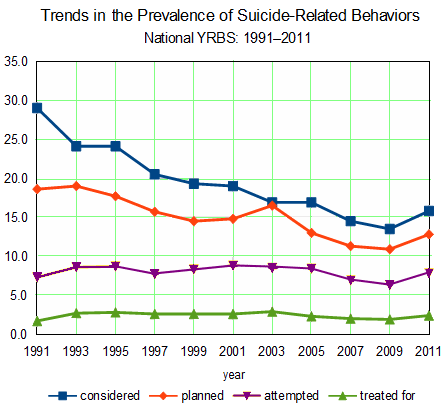In the first post about the
Lu et al study, I mentioned the CDC 1979-2007 suicide data [see
a madness to our method…]. But in
its origin…, my post had a broken link to the CDC
YRBS [Youth Risk Behavior Study] in the Rapid Response by
Barber et al. That was an unfortunate omission as it’s a center ring piece of information. First, here’s the CDC Suicide data [1979-2007]:
Here’s my graphing of the
YRBS data [1991-2011]:
The
Youth Risk Behavior Surveillance System [YRBSS] was actually new for me. It’s an every other year survey querying dangerous behaviors in kids 16-19. It looks pretty solid to me and I was glad to find it. Take a look. It certainly doesn’t confirm the findings of
Lu et al [in fact, most things don’t].
I honestly don’t believe that the black box warnings lead to an increase in either suicides or suicide attempts based on scientific grounds, some of which are shown here. But that’s not what fuels my writing about this. What keeps me writing is what I do believe, not what I don’t believe. I’ve seen two completed suicides from SSRIs that I’m sure about. Thankfully, neither was a patient of mine, but I was privy to enough information to be unquestioning about what happened. I may fill this blog with graphs and population statistics, but as a clinician, I’m a one-person-at-a-time doctor. And people like me are at a loss because I can’t or won’t report why I can say that with such conviction. I also believe in Akathisia of the kind that’s described in patient reports, books, on RxISK, in blogs etc. I believe it because I’ve seen it personally in its very loud forms. I can’t or won’t report the stories that lead to that conviction either, so I can only say that I have no doubts. I think the black box warning is correct – the truth:

If someone actually did a non-jury rigged study that said that the black box warning is wrong, I wouldn’t change a single thing in the way I personally do things. David Healy says why best when he talks about getting doctors to "doubt our own eyes." See Akathisia once, a dramatic change in personality and the aggression that comes with the drug, that then disappears when the drug is withdrawn, and you’re on alert. See it the second time and that’s enough for this old man. It might as well be an epidemic. And given the fact that I’m an infrequent prescriber, that I’ve seen it often enough makes it real for me. I would bet it’s even under-reported because the patients stop that drug and don’t go back to see that doctor. I’ve prescribed SSRIs to adolescents and young adults infrequently, and only when I’ve said my spiel and am comfortable that I and competent others can keep close tabs. I can’t imagine anything ever changing that. There have been some successes, some failures, and much indifference. So I’m glad the black box warning slowed down the accelerating rate of prescribing – even in an HMO. And what I’ve seen with my eyes trumps epidemiology on large datasets.



SSRIs can create such altered states of mind, that I do believe that little about how the drugs effect a person is related to that person in a way that could be deduced as a personal issue.
You know what I mean?
If a teenager took a lot of acid and then went surfing and drowned (which a woman I knew described as a routine occurrence in California during the initial craze in California) then it would make little sense to try to parse whether or not that teen was suicidal— it was beside the point— their judgment was impaired beyond their comprehension and control. Once the drug culture developed a buddy system and told people what to expect, then the death rate for LSD dropped significantly.
The state I was in on desipramine was fortunately a happy state, but no too happy. People kept thanking me for my patience— does that sound like mania?— but I wasn’t being patient, I simply had no judgment whatsoever. My good fortune amazes me still, the possibilities of what I might have done on that drug have nothing to little to do with who I am or how I’m organized. It was just a trip and it could have turned out a lot worse.
And I was 34. How does a teen deal with that, especially when no one has fully warned them about the kinds of things that could happen? Would relaying such information appropriately challenge the whole premise for prescribing such drugs in the first place? When the drugs are making teens suicidal— teens that are told that the drugs are supposed to keep them from being suicidal; THEN CAN’T WE STOP THIS TRAIN AND GET OFF RIGHT NOW?
Getting parents to doubt our own eyes is evil too!
I definitely experienced akesthesia on a very small dose of Celexa several years ago. There is no doubt in my mind that if I had listened to my psychiatrist’s advice to stay on the med, that something very bad would have happened. I decided it was better to switch back to a med that was previously causing foot pain and ended up doing it again.
It is just beyond comprehension that my psychiatrist and many in a similar situation don’t recognize or don’t want to recognize that when you have a bad reaction to a med as I did, that it needs to be discontinued immediately.
Initially, I was going to say this wouldn’t happen with “regular” medicine but now I realize that isn’t exactly accurate as many folks for example have complained about statin side effects only to be blown off by their doctors.
People frequently come on my site and say antidepressants made them suicidal with no previous thoughts of suicide, ever. For the most part, these are ordinary people with the usual vague or non-existent psychiatric diagnoses.
And, of course, inconsistent dosing or withdrawal syndrome definitely makes people talk frequently about suicide. One person killed himself last week.